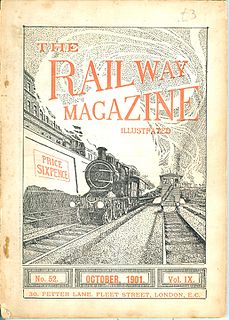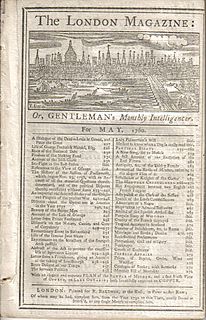Related Research Articles

Mary Elizabeth Braddon was an English popular novelist of the Victorian era. She is best known for her 1862 sensation novel Lady Audley's Secret, which has also been dramatised and filmed several times.

If was an American science fiction magazine launched in March 1952 by Quinn Publications, owned by James L. Quinn.

Henry Austin Dobson, commonly Austin Dobson, was an English poet and essayist.

The Strand Magazine was a monthly British magazine founded by George Newnes, composed of short fiction and general interest articles. It was published in the United Kingdom from January 1891 to March 1950, running to 711 issues, though the first issue was on sale well before Christmas 1890. Its immediate popularity is evidenced by an initial sale of nearly 300,000. Sales increased in the early months, before settling down to a circulation of almost 500,000 copies a month, which lasted well into the 1930s.

Sir Walter Besant was an English novelist and historian. William Henry Besant was his brother, and another brother, Frank, was the husband of Annie Besant.

Eliza Lynn Linton was the first female salaried journalist in Britain and the author of over 20 novels. Despite her path-breaking role as an independent woman, many of her essays took a strong anti-feminist slant.

The Illustrated London News appeared first on Saturday 14 May 1842, as the world's first illustrated weekly news magazine. Founded by Herbert Ingram, it appeared weekly until 1971, then less frequently thereafter, and ceased publication in 2003. The company continues today as Illustrated London News Ltd, a publishing, content, and digital agency in London, which holds the publication and business archives of the magazine.

The Railway Magazine is a monthly British railway magazine, aimed at the railway enthusiast market, that has been published in London since July 1897. As of 2010 it was, for three years running, the railway magazine with the largest circulation in the United Kingdom, having a monthly average sale during 2009 of 34,715. It was published by IPC Media until October 2010, with ISSN 0033-8923, and in 2007 won IPC's 'Magazine of the Year' award. Since November 2010, The Railway Magazine has been published by Mortons of Horncastle.

The London Magazine is the title of six different publications that have appeared in succession since 1732. All six have focused on the arts, literature and miscellaneous topics.

The American Magazine was a periodical publication founded in June 1906, a continuation of failed publications purchased a few years earlier from publishing mogul Miriam Leslie. It succeeded Frank Leslie's Popular Monthly (1876–1904), Leslie's Monthly Magazine (1904–1905), Leslie's Magazine (1905) and the American Illustrated Magazine (1905–1906). The magazine was published through August 1956.
The three-volume novel was a standard form of publishing for British fiction during the nineteenth century. It was a significant stage in the development of the modern novel as a form of popular literature in Western culture.
Ward, Lock & Co. was a publishing house in the United Kingdom that started as a partnership and developed until it was eventually absorbed into the publishing combine of Orion Publishing Group.
William Pickering was an English publisher and bookseller, notable for various innovations in publishing. He is sometimes credited with introducing edition binding in cloth to British publishing.
Annie Hall Cudlip, writing as Mrs. Pender Cudlip) was an English novelist and writer. She edited Ours: A Holiday Quarterly and contributed regularly to All the Year Round, Frank Leslie's Popular Monthly, and other magazines in Britain and the United States between 1876 and 1884. Married to a theologian, Rev. Pender Hodge Cudlip, she was among the most prolific writers of romantic fiction: well over 100 novels and short stories between 1862 and the early 20th century. The best known include Theo Leigh (1865), A Passion in Tatters (1872), He Cometh Not, She Said (1873) and Allerton Towers (1882).
Temple Bar was a literary periodical of the mid and late 19th and very early 20th centuries (1860–1906). The complete title was Temple Bar – A London Magazine for Town and Country Readers. It was initially edited by George Augustus Sala, and Arthur Ransome was the final editor before it folded, while he developed his literary career. It was also edited by Mary Elizabeth Braddon.
Stanley Llewellyn Wood was a prolific Welsh illustrator who travelled widely. He was known for his portrayals of horses in action and also for his black-and-white illustrations for the Captain Kettle stories by C. J. Cutcliffe Hyne.

Everybody's Magazine was an American magazine published from 1899 to 1929. The magazine was headquartered in New York City.

Frank Atha Westbury, who wrote under the pen names of "Atha" and "Atha Westbury", was a popular and prolific author of mystery adventure novels, children's stories and poetry in late 19th century Australia and New Zealand. Most of his fiction was serialised in newspapers and journals between 1879 and 1905. His two major works were: The Shadow of Hilton Fernbrook, A Romance of Maoriland (1896) and Australian Fairy Tales (1897), which won him a place as one of the better-known writers for children in Victorian-era Australia. Many of his novels were adventure romances set in New Zealand at the time of the New Zealand Wars of the 1860s, which the author experienced as a soldier in the British Army.

Andrew Chatto was an English book publisher who was renowned for the cordial relations he maintained with his authors.
References
- Laurel Brake and Marysa Demoor (2009). Dictionary of Nineteenth-century Journalism in Great Britain and Ireland (Gent: Academia Press, ISBN 978-90-382-1340-8) pp. 44–45.